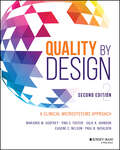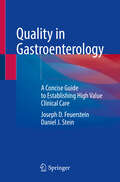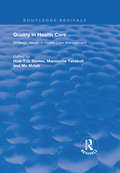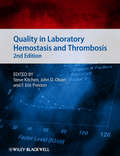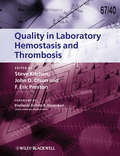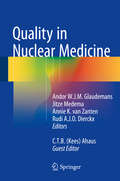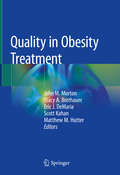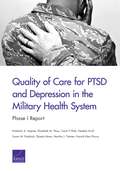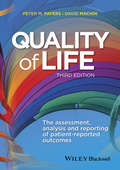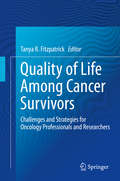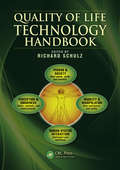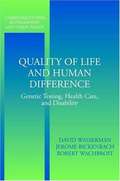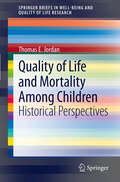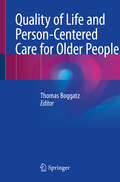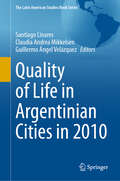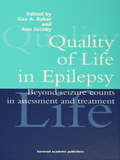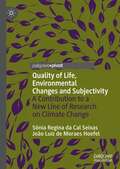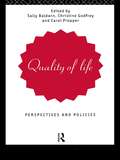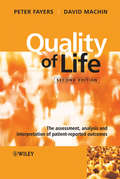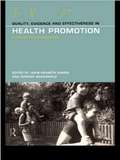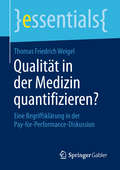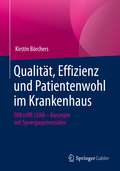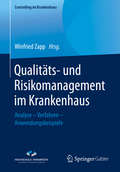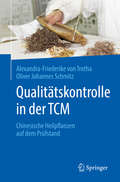- Table View
- List View
Quality by Design: A Clinical Microsystems Approach
by Eugene C. Nelson Paul B. Batalden Marjorie M. Godfrey Julie K. Johnson Tina C. FosterThe latest edition of the bestselling text on quality improvement in health care, providing powerful theoretical frameworks and principles, valuable tools and techniques, and a proven action-learning program Now in its second edition, Quality By Design contains an evidence and practice based strategy for teaching and practicing the clinical microsystem approach across all levels of health care organizations. Overall, the microsystem approach continues to evolve and adapt to meet the changing needs of healthcare organizations. Ongoing research, the development of updated models, and innovative applications across diverse settings demonstrate the approach’s potential to transform healthcare delivery and improve outcomes for patients and staff alike. This innovative volume provides research and practical results based on the original high-performing clinical microsystems research conducted at The Dartmouth Institute for Health Policy and Clinical Practice. Quality By Design, Second Edition, advances clinical microsystem theory and practice with new material and updates:New in the Second Edition: Global Impact: The microsystem approach has gained traction internationally, with healthcare organizations and universities in various countries successfully adapting and implementing the approach in specific healthcare cultural and contextual nuances. Real-world case studies showcase the microsystem approach’s success across diverse healthcare settings. Patient-Centered Care: Emphasis on coproduction of care, where patients and families are active partners in improvement Meeting Standards: Guidance on using the microsystem framework including effective meeting skills to ensure productivity and value of meetings. Team Coaching: Team Coaching case studies demonstrate its effectiveness in empowering frontline teams and improving their capabilities. Simultaneously, insights into multi-level leadership guide horizontal and vertical integration efforts for organizational success. Workforce Development and Well-being: Updated strategies for interprofessional education and development early in a career and throughout a career to learn to provide care and improve care is included System-Wide Improvement: New models and insights underscores the importance of integrating micro, meso, and macro systems to create a cohesive and efficient healthcare system. This involves aligning goals, processes, and communication across different levels of the organization. Data-Driven Decision Making: Strategies for building information-rich environments and leveraging data at all levels including key measurement and change management techniques. Patient Safety and Reliability: A personal case study offers a fresh perspective on error prevention and improving reliability Action Guide: An updated guide to accelerating improvement in clinical mesosystems. Remember: Successful implementation of the microsystem approach requires a long-term commitment to continuous learning, collaboration, and adaptation. By fostering a culture of improvement and empowering staff at all levels, organizations can harness the power of microsystems to achieve their quality and safety goals. This expanded edition solidifies Quality by Design as an indispensable resource for anyone committed to transforming healthcare through the power of microsystems.
Quality in Gastroenterology: A Concise Guide to Establishing High Value Clinical Care
by Daniel J. Stein Joseph D. FeuersteinThis book is an all-in-one resource on providing and establishing high quality care in clinical gastroenterology. The text provides an in-depth analysis of not just guideline-based care, which is usually covered in shorter articles, but a combination of guidelines, quality metrics, and general standard of care in all areas of clinical practice and endoscopy. The book also covers high quality care for specific gastrointestinal disease states, such as inflammatory bowel disease, motility disorders, and pancreatic diseases, reviewing the appropriate timing of procedures for those conditions. Each chapter features a table of key quality measures for easy use and access. The chapters also discuss avoiding overuse of procedures, as well as instances where it may not be indicated to perform procedures. In addition, this volume combines the standards put forth by many different societies and groups into a single source for providers to use as a blueprint for standards of high quality care. Quality in Gastroenterology summarizes everything a practicing clinician needs for providing high quality care in one convenient place.
Quality in General Practice
by Ellie Scrivens Steve Field Katherine BirchThe recent shifts in power, resources, influence and responsibility in primary care has increased the strain on general practice. This book is a comprehensive guide to the wide range of quality schemes available. It is unique in examining quality within the context of current practice, and it discusses future options based on new examples and research. It outlines the development of clinical governance, strategies for managing and assessing quality, continuing professional development, Department of Health policy initiatives and future trends.
Quality in Health Care: Strategic Issues in Health Care Management
by Manouche TavakoliThis title was first published in 2001. Enhancing the quality of health services remains a key challenge for all health systems, whatever their stage of development. This collection of leading-edge research from Europe and America explores both quantitative and qualitative approaches to identifying and remedying deficiencies in health care.
Quality in Laboratory Hemostasis and Thrombosis
by Steve Kitchen John D. Olson F. Eric PrestonThe hemostasis laboratory has a vital role in the diagnosis and management of patients with familial and acquired haemorrhagic and thrombotic disorders. Its role in the monitoring of traditional anticoagulant therapy, as well as therapy using new anticoagulants, presents new challenges to the laboratory. This new edition addresses these important issues, as well as international guidelines for testing, the development of international standard materials, management of haemostasis testing from the laboratory to the point-of-care, and molecular genetic testing.
Quality in Laboratory Hemostasis and Thrombosis
by Steve Kitchen John D. Olson F. Eric Preston"Over the last decades, major progress has been made in quality assurance of hemostatic laboratory assays. This book will be an indispensable part of every hemostasis laboratory, where, given its hands-on nature, it will rarely sit to get dusty on the shelves." —Frits R. Rosendaal, Leiden University Medical Center The hemostasis laboratory has a vital role in the diagnosis and management of patients with familial and acquired hemorrhagic and thrombotic disorders. Its role in the monitoring traditional anticoagulant therapy as well as therapy using new anticoagulants presents new challenges to the laboratory. Quality in Laboratory Hemostasis and Thrombosis not only addresses these important issues, but also covers international guidelines for testing, the development of international standard materials, management of hemostasis testing from the laboratory to the point of care as well as molecular genetic testing. Designed as a guide for all those working in hemostasis laboratories, this book details a quality program that, when put into place, will help to improve standards in testing. All of the authors are internationally recognised for their work in hemostasis and thrombosis. Using their experience, they provide information on standards, equipment and methods that will guide the development of a quality program to support all activities in the hemostasis laboratory.
Quality in Nuclear Medicine
by Rudi A.J.O. Dierckx Andor W.J.M. Glaudemans Jitze Medema Annie K. van Zanten C. T. B. Kees AhausThis comprehensive textbook provides a state of the art overview of the means by which quality in patient care is ensured within the field of nuclear medicine. Acknowledged experts in the field cover both management aspects, such as laws, standards, guidelines, patient safety, management instruments, and organisations, and specific issues, including radiation safety and equipment. Quality in Nuclear Medicine not only presents detailed information on the topics discussed but should also stimulate further discussion and offer an important tool to all professionals in the field of nuclear medicine and their stakeholders. Readers will find that the book provides a wealth of excellent guidance and reflects the pioneering role of nuclear medicine in advancing different aspects of quality within medicine.
Quality in Obesity Treatment
by John M. Morton Stacy A. Brethauer Scott Kahan Eric J. DeMaria Matthew M. HutterThis book reviews quality definition, measurement, improvement, value, and accountability for obesity management. The interplay between quality, cost, access and satisfaction is fully depicted with a goal toward not only fulfilling current standards but also anticipating future needs. A thorough inventory of current best practices in all aspects of obesity care is cataloged with a gap analysis also employed for potential areas of improvement to be road mapped. All chapters are written by experts in their fields and include the most up-to-date scientific and clinical information, take home messages, and questions towards following the requirements of quality certification in obesity management. Quality in Obesity Treatment provides a comprehensive, contemporary review of this field and serves as a valuable resource for Bariatric Surgeons, Primary Care Physicians, Policy Makers, Insurance Administrators, Bariatricians, and any medical specialty interested in obesity quality management with likely candidates coming from GI, endocrinology, cardiology, sleep medicine and orthopedics.
Quality of Care for PTSD and Depression in the Military Health System
by Susan M. Paddock Elizabeth M. Sloss Harold Alan Pincus Heather Krull Kimberly A. Hepner Carol P. Roth Martha J. Timmer Shaela MoenUnderstanding the current quality of care for posttraumatic stress disorder (PTSD) and depression delivered to service members is an important step toward improving care across the Military Health System (MHS). T.his report describes the characteristics of active-component service members who received care for PTSD or depression through the MHS and assesses the quality of care received using quality measures derived from administrative data
Quality of Life
by David Machin Peter FayersQuality of life studies form an essential part of the evaluation of any treatment. Written by two authors who are well respected within this field, Quality of Life: The Assessment, Analysis and Interpretation of Patient-reported Outcomes, Second Edition lays down guidelines on assessing, analysing and interpreting quality of life data. The new edition of this standard book has been completely revised, updated and expanded to reflect many methodological developments emerged since the publication of the first edition. Covers the design of instruments, the practical aspects of implementing assessment, the analyses of the data, and the interpretation of the resultsPresents all essential information on Quality of Life Research in one comprehensive volumeExplains the use of qualitative and quantitative methods, including the application of basic statistical methodsIncludes copious practical examplesFills a need in a rapidly growing area of interestNew edition accommodates significant methodological developments, and includes chapters on computer adaptive testing and item banking, choosing an instrument, systematic reviews and meta analysisThis book is of interest for everyone involved in quality of life research, and it is applicable to medical and non-medical, statistical and non-statistical readers. It is of particular relevance for clinical and biomedical researchers within both the pharmaceutical industry and practitioners in the fields of cancer and other chronic diseases.Reviews of the First Edition - Winner of the first prize in the Basis of Medicine Category of the BMA Medical Book Competition 2001:"This book is highly recommended to clinicians who are actively involved in the planning, analysis and publication of QoL research." CLINICAL ONCOLOGY"This book is highly recommended reading." QUALITY OF LIFE RESEARCH
Quality of Life Among Cancer Survivors
by Tanya R. FitzpatrickThis multidisciplinary reference explores the concepts and realities of quality of life among cancer survivors in its physical, psychological, cognitive, social, and familial dimensions. Informed by a broad range of fields including genetics, psychiatry, nursing, dentistry, rehabilitation, and ethics, it addresses daily challenges of living for this population, from self-care to cultural concerns and from social interactions to experiences with providers. Family issues of pediatric, young adult, and elder survivors, caregiving parents, and siblings are a major area of concern. And contributors describe interventions for survivors as individuals, in family content, and as part of integrated care across primary and specialty settings. Included among the topics: Play, leisure activities, and cognitive health among older cancer survivors. Genetic mutations in cancer susceptibility genes: a family history of cancer. Cancer patients in a pediatric intensive care unit: a single center experience. The impact of childhood cancer on the quality of life among healthy siblings. When cancer returns: family caregivers and the hospice team. Experiencing cancer services: a story of survival and dissatisfaction. A significant addition to the cancer survivorship literature, Quality of Life Among Cancer Survivors is a practice-building resource for oncology and allied health professionals, health psychologists, and social workers, as well as researchers in these fields.
Quality of Life Technology Handbook (Rehabilitation Science in Practice Series)
by Richard SchulzA collaboration between leading scientists, practitioners, and researchers at Carnegie-Mellon University and the University of Pittsburgh, this book is a comprehensive resource describing Quality of Life technologies and their development, evaluation, adoption, and commercialization. It takes an interdisciplinary team approach to the process of tec
Quality of Life and Human Difference: Genetic Testing, Health Care, and Disability
by Jerome Bickenbach David Wasserman Robert WachbroitThis study brings together two important literatures one volume. One concerns the role of quality assessments in social policy, especially health policy. The second concerns ethical and social issues raised by prenatal testing for disability. Hitherto, these two literatures have had little contact with each other: few scholars have written about both, or have compared the two domains in a systematic way, while people with disabilities and disability scholars are underrepresented in recent discussion on health policy and quality of assessment. This book turns the perspectives of disability scholars on issues that have largely been the province of health methodology, policy and philosophy, while angling philosophical policy analysis on problems that have largely been the province of disability scholarship. This volume will be sought after by bioethicists, philosophers, and specialists in disability studies and healthcare economics.
Quality of Life and Mortality Among Children
by Thomas E. JordanThis birefs examines mortality among young children in the period from the seventeenth to the nineteenth century. It does so using several types and sources of information from the census unit England and Wales, and from Ireland. The sources of information used in this study include memoirs, diaries, poems, church records and numerical accounts. They offer descriptions of the quality of life and child mortality over the three centuries under study. Additional sources for the nineteenth century are two census-derived numerical indexes of the quality of life. They are the VICQUAL index for England and Wales, and the QUALEIRE index for Ireland. Statistical procedures have been applied to the numbers provided by the sources with the aim to identify effects of and associations between such variables as gender, age, and social background. The briefs examines the results to consider the impact of children's deaths upon parents and families, and concludes that there are differences and continuities across the centuries.
Quality of Life and Person-Centered Care for Older People
by Thomas BoggatzThis book explores the meaning of quality of life in care for older persons and introduces the reader to their main concerns when receiving care. Based on qualitative research, it pays particular attention to the needs and requirements of older people, considering their individual family situations, social circumstances, values and lifestyles. Person-centred care is a way of providing nursing care that puts older people and their families at the core of all decisions, seeing each person as an individual, and working together to develop appropriate solutions. Following an introduction to the concept of quality of life in old age, the book reviews essential findings from worldwide research into the experiences of older people with regard to nursing care and the impact of these experiences on their quality of life. It investigates health promotion, care provided in nursing homes and assisted living facilities, and palliative care. Each chapter includes a brief introduction to the respective field of nursing care and the problems it has to deal with, concluding with a discussion of their implications for nursing practice in the respective field of care. In closing, the evidence from qualitative research is discussed in relation to current gerontological theories.
Quality of Life in Argentinian Cities in 2010 (The Latin American Studies Book Series)
by Claudia Andrea Mikkelsen Santiago Linares Guillermo Ángel VelázquezThis book introduces a quality of life index that compares the intra-urban particularities of 23 cities in the Argentine Republic. Integrating demographic size, functional specialization, and regional location, the chapters employ a standard set of variables to assess socioeconomic and environmental inequality and wellbeing. A result of collaboration between 33 contributors from institutions around the country, the book provides a rich assessment of the mechanisms and processes by which the residential areas of Argentinian cities form, change, develop, and decline. Consistent measures of education, health, housing, and environmental wellbeing allow for deep examinations of each area and meaningful comparisons between them. The book also explores patterns that recur in multiple cases. Redevelopment and renewal processes in central and old areas of cities can lead to the creation or reenergization of modern, high-density neighborhoods that, benefitting from new construction and integrated commercial and service areas, exhibit high quality of life indices. Urban expansion stands out as a process that often results in or reinforces socio-spatial segregation: New, exclusive, low-density residential neighborhoods with single-family homes and green areas tend to have a high level of quality of life, thanks to good education, health services, housing, and natural amenities. In contrast, low-income neighborhoods with precarious housing, limited access to health and education services, and unfavorable environments exhibit lower quality of life measures. Increasingly common gated communities—with private security, exclusive services, and (internally) shared recreational spaces—reinforce this pattern of segregation. Analyzing the quality of life in different Argentinian cities is important to understanding the living conditions of the inhabitants, identifying areas for improvement, and supporting the development of inclusive and sustainable policies. These measurements can facilitate more just and prosperous environments for all citizens.
Quality of Life in Epilepsy: Beyond Seizure Counts in Assessment and Treatment
by Gus A. Baker Ann JacobyThough clinical aspects of epilepsy such as seizure control are crucially important to its management, increasing attention is being given to wider quality of life issues. Epilepsy continues to be an often misunderstood and stigmatising condition; for the vast majority of people whose seizures can be well controlled, the social and psychological repercussions are often of greater significance than the seizures themselves.The increasing emphasis on the importance of non-clinical outcomes in the assessment of new treatments and management strategies for chronic conditions such as epilepsy has stimulated interest in methodological issues in assessing quality of life. This book reviews the recent literature on the impact of epilepsy on everyday experience and the methodological issues involved in assessing that impact. It also considers the perspectives of a range of health professionals involved in caring for people with epilepsy and how, through appropriate management, the impact on their lives can be minimised.
Quality of Life, Environmental Changes and Subjectivity: A Contribution to a New Line of Research on Climate Change
by Sônia Regina da Cal Seixas João Luiz de Moraes HoefelIn this volume, the authors consider how environmental changes affect our social, cultural and political lives and, in doing so, have a direct influence on individuals’ health. In contrast to previous research in the area, da Cal Seixas and de Moraes Hoefel emphasize both physical health and mental health as measures of human suffering, in an approach informed by the concept of subjectivity. Ultimately, the authors argue that contemporary environmental changes have a significant effect on the mental and physical wellbeing of the world’s population, and that analysis and proposals for action should address both concerns in an effort to improve our quality of life.
Quality of Life: Perspectives and Policies
by Sally Baldwin Carol Propper Christine GodfreyConcern about the quality of life and its measurement is probably greater now than ever before. The last five years have seen considerable changes in policy, particularly in health and social service markets bringing into question appropriate measures of input and output. The issues addressed in this volume range from the philosophical question of what the good life is, to detailed studies of what constitutes a good quality of life for particular client groups.Quality of Life will be valuable reading for researchers and practitioners in social policy, social work and economics.
Quality of Life: The Assessment, Analysis and Interpretation of Patient-reported Outcomes
by David Machin Peter M. FayersQuality of life studies form an essential part of the evaluation of any treatment. Written by two authors who are well respected within this field, Quality of Life: The Assessment, Analysis and Interpretation of Patient-reported Outcomes, Second Edition lays down guidelines on assessing, analysing and interpreting quality of life data. The new edition of this standard book has been completely revised, updated and expanded to reflect many methodological developments emerged since the publication of the first edition. Covers the design of instruments, the practical aspects of implementing assessment, the analyses of the data, and the interpretation of the results Presents all essential information on Quality of Life Research in one comprehensive volume Explains the use of qualitative and quantitative methods, including the application of basic statistical methods Includes copious practical examples Fills a need in a rapidly growing area of interest New edition accommodates significant methodological developments, and includes chapters on computer adaptive testing and item banking, choosing an instrument, systematic reviews and meta analysis This book is of interest for everyone involved in quality of life research, and it is applicable to medical and non-medical, statistical and non-statistical readers. It is of particular relevance for clinical and biomedical researchers within both the pharmaceutical industry and practitioners in the fields of cancer and other chronic diseases. Reviews of the First Edition – Winner of the first prize in the Basis of Medicine Category of the BMA Medical Book Competition 2001: “This book is highly recommended to clinicians who are actively involved in the planning, analysis and publication of QoL research.” CLINICAL ONCOLOGY “This book is highly recommended reading.” QUALITY OF LIFE RESEARCH
Quality, Evidence and Effectiveness in Health Promotion: Striving For Certainties
by Gordon Macdonald John Kenneth DaviesQuality, Evidence and Effectiveness is unique in bringing together, for the first time, the critical concepts of quality assurance and effectiveness in relation to health promotion and research.Contributions from leading health promotion specialists around the world discuss how best to push forward evidence of the value of health promotion as an effective investment strategy. They examine particular examples of health promotion interventions, focusing on both practical suggestions and the concepts underlying them.Contributions are divided into three core sections:* the examination of effectiveness studies through the application of different evaluation methodologies * practice-based quality assurance programmes * the examination of examples of health promotion interventionsQuality, Evidence and Effectiveness will be invaluable to students, researchers and policy-makers in health promotion and all professionals who are committed to the effective and efficient delivery of New Public Health.
Qualität in der Medizin quantifizieren?: Eine Begriffsklärung in der Pay-for-Performance-Diskussion (essentials)
by Thomas Friedrich WeigelIn dem vorliegenden Buch wird die Messung der Ergebnisqualität durch Qualitätsindikatoren rekonstruiert und anhand von Beispielen, vor allem aus dem Bereich der Chirurgie, näher betrachtet. Bei dem Konzept der qualitätsorientierten Vergütung (pay for performance) werden Klinikabteilungen insgesamt beurteilt. Dabei werden komplexe Behandlungsabläufe mit Hilfe von einigen Parametern (Qualitätsindikatoren) zusammenfassend als Ergebnisqualität beurteilt und bewertet. Der Autor Thomas Friedrich Weigel diskutiert die Grundlagen der quantitativen Beurteilungen und leistet damit einen wichtigen Beitrag zu der Debatte über die Qualitätsmessung im Medizinsystem.
Qualität, Effizienz und Patientenwohl im Krankenhaus: DIN trifft LEAN – Konzepte mit Synergiepotenzialen
by Kirstin BörchersEine medizinische Versorgung, die sich am Wohle des Menschen orientiert, verknüpft mit einer Kultur des Gelingens - hierin liegt die Zukunft. Gerade die COVID-19-Pandemie hat gezeigt, wie wichtig Qualität und Effizienz im Sinne des Patientenwohls im Krankenhaus sind. Qualitätsmanagement und Lean Management können voneinander profitieren und beide haben das Potenzial, gemeinsam ein erfolgreiches integriertes Managementsystem zu bilden. Sowohl DIN als auch LEAN fokussieren in ihrer Entwicklung den prozessorientierten Ansatz für mehr Qualität, die Notwendigkeit der kontinuierlichen Verbesserung sowie ein effizientes Arbeiten.Dieses Buch gibt zahlreiche Impulse zur erfolgreichen Zusammenarbeit im Sinne „DIN trifft LEAN“. Nach einer Einführung in die zugrunde liegenden Theorien schließen sich zwei Kapitel zur Lean-Philosophie und DIN EN ISO 9000-Qualitäts-Philosophie im Krankenhaus an. Dass es sich bei den beiden Philosophien um „universelle Einstellungen“ handelt, wird an den gezeigten Beispielen „Polwettlauf Südpol“ und „Bergrettung“ deutlich. Sie sind zugleich Lehrstücke in Führung und Lean Leadership. Die 25 etablierten und erfolgreichen Arbeitsweisen zur Bewertung und Verbesserung von Qualität, Effizienz und Patientenwohl im Krankenhaus mit anschaulichen Beispielen im Kapitel „Best Practice“ können sofort umgesetzt werden.
Qualitäts- und Risikomanagement im Krankenhaus: Analyse – Verfahren – Anwendungsbeispiele (Controlling im Krankenhaus)
by Winfried ZappDas Qualitäts- und Risikomanagement im Gesundheitswesen hat in den vergangenen Jahren zunehmend an strategischer Bedeutung gewonnen: Durch jüngere Gesetzesänderungen können Verfehlungen im Bereich der Qualität und der Fehleinschätzung des Risikos direkten negativen Einfluss auf das Leistungsgeschehen des Krankenhauses nehmen. Dieses Fachbuch führt in das Thema Qualitäts- und Risikomanagement und deren Ausgestaltung im Krankenhaus ein. Es zeigt die Rahmenbedingungen im Gesundheitswesen auf und stellt zunächst die Analyse und Optimierung klinischer Behandlungspfade als grundlegendes Instrument vor, um erfolgreiches Qualitäts- und Risikomanagement miteinander zu verbinden. Ergänzende Transparenz schaffen klinisches Prozessmanagement, Casemanagement und unterstützende Kennzahlensysteme. Der zweite Teil des Buches fokussiert vor allem auf zwei konkrete Instrumente des Risikomanagements und stellt diese ausführlich vor: Das Critical Incident Reporting System (CIRS) und das Global Trigger Tool (GTT) werden analysiert und verglichen und so die Methoden, Unterschiede sowie Stärken und Schwächen abgeleitet. Die Ausführungen sind dabei anwendungsorientiert dargestellt und mit Praxisbeispielen hinterlegt. Das Buch möchte so eine praxisnahe Entscheidungshilfe für Führungskräfte sein, um für das individuelle Krankenhaus das jeweils passende Verfahren finden zu können.
Qualitätskontrolle in der TCM: Chinesische Heilpflanzen auf dem Prüfstand
by Oliver Johannes Schmitz Alexandra-Friederike von TrothaDie Traditionelle Chinesische Medizin (TCM) und die Verwendung chinesischer Arzneidrogen und ihre Zubereitungen erfreuen sich hierzulande als Alternative zur Schulmedizin immer größerer Beliebtheit Um die Sicherheit, Wirksamkeit und konstant hochwertige Qualität der Arzneien für Patienten zu gewährleisten ist eine Qualitätskontrolle unerlässlich. Das Buch führt im Grundlagenteil in die Geschichte und Philosophie der TCM ein, zeigt die wirtschaftliche Bedeutung von Heilpflanzen, erklärt die Wirkung der Vorbehandlungsmethoden (Paozhi-Verfahren) und vor allem die Gefahren der unreflektierten Einnahme. Der größere Teil widmet sich den Gründen und Methoden einer vernünftigen Qualitätskontrolle von chinesischen Heilpflanzen. Unter anderem werden wichtige Themen wie Toxizität, mögliche Belastungen mit Pestiziden, Schwermetallen oder Mykotoxine diskutiert. Nur weil ein Produkt natürlichen Ursprungs ist, darf kein Rückschluss auf kein Gefährdungspotenzial geschlossen werden. Das Buch richtet sich an naturheilkundlich tätige Ärzte, Pharmazeuten, Apotheker und an Heilpflanzen interessierte Personen.
